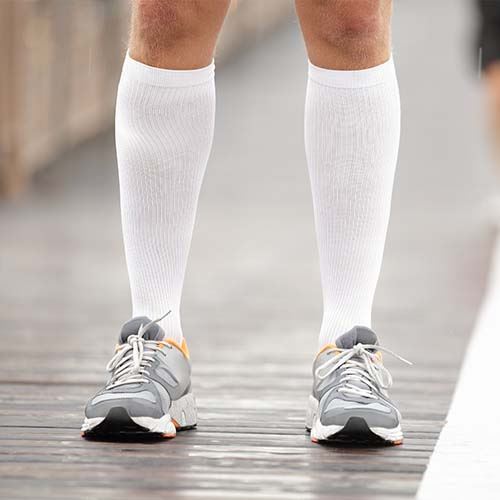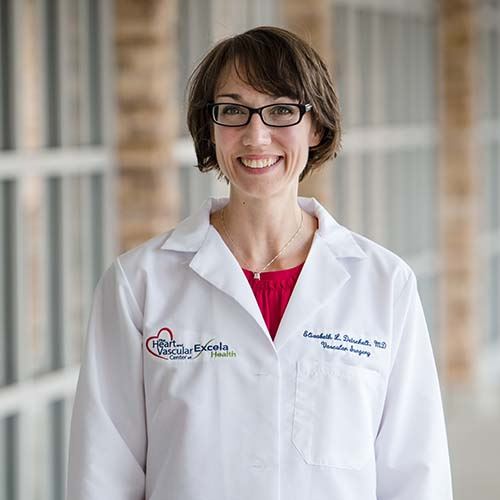Varicose Veins or Varicose ‘Vain’?
- Category: Blog, Vascular Surgery
- Posted On:
- Written By: Elizabeth Detschelt

No one enjoys having roadmaps of veins creeping up the leg or under the hem of their shorts, but is it truly dangerous to leave varicose veins untreated? Swollen or enlarged veins that typically appear on the legs and feet are called varicose veins. They range in color from a bluish tinge to a deep purple and can sometimes be lumpy or bulging out of the leg. Excela Health Vascular Surgeon and Director of the Excela Health Vein Center, Elizabeth Detschelt, MD, FACS states, “Although varicose veins may not be ideal, they aren’t always dangerous to a person’s health. However, there are certain situations where varicose veins can lead to a decreased quality of life – pain, achiness in the legs, disrupted sleep – and a visit to the Vein Center may be able to help with this.”
No one enjoys having roadmaps of veins creeping up the leg or under the hem of their shorts, but is it truly dangerous to leave varicose veins untreated? Swollen or enlarged veins that typically appear on the legs and feet are called varicose veins. They range in color from a bluish tinge to a deep purple and can sometimes be lumpy or bulging out of the leg. Excela Health Vascular Surgeon and Director of the Excela Health Vein Center, Elizabeth Detschelt, MD, FACS states, “Although varicose veins may not be ideal, they aren’t always dangerous to a person’s health. However, there are certain situations where varicose veins can lead to a decreased quality of life – pain, achiness in the legs, disrupted sleep – and a visit to the Vein Center may be able to help with this.”
Who gets varicose veins?
If your close family members have varicose veins, you may be destined for them as well, especially if you are female – as it occurs most often in women. However, there are other factors that increase your likelihood of developing varicose veins such as being overweight, on your feet for long periods of time, or pregnancy all increase your chances of developing varicose veins.
What causes varicose veins?
In a healthy vein, blood flows smoothly to the heart. The blood is prevented from flowing backward by a series of tiny valves acting like little doors, that open and close to let blood through. The doors are only supposed to open one way, directing the blood to the heart. Varicose veins, however, may develop when the small valves inside the veins stop working properly. If the valves (little doors) weaken or are damaged, the blood can flow backward and collect in the vein, eventually causing it to be swollen and enlarged (varicose).
Is there anything I can do to make it better without a physician’s help?
There is no magic pill or essential oil to eliminate or prevent varicose veins. However, there are a few things that you can do to ease the symptoms of existing veins. Dr. Detschelt recommends wearing compression stockings whenever you are going to be on your feet for extended periods of time. Or if you must be on your feet, move around every thirty minutes and rest/elevate your legs if possible. Mostly, regular exercise can help to regulate your body weight and prevent extra stress on the veins.
If you have varicose veins and are becoming problematic – making for painful and uncomfortable legs, sore and irritated skin over the veins, or the pain in your legs is waking you up at night – help is available.
 Dr. Detschelt advises “There is no reason to live your life in pain. The first step is to do your research and find a center with the appropriate accreditation to treat your condition.” For vein clinics, that would be an Intersocietal Accreditation Commission (IAC) accredited center. This ensures that the center meets the benchmarks for quality based on resources, training, and outcomes. If a center is IAC accredited – you can feel confident that the facility is safe and medically competent to handle your problem.
Dr. Detschelt advises “There is no reason to live your life in pain. The first step is to do your research and find a center with the appropriate accreditation to treat your condition.” For vein clinics, that would be an Intersocietal Accreditation Commission (IAC) accredited center. This ensures that the center meets the benchmarks for quality based on resources, training, and outcomes. If a center is IAC accredited – you can feel confident that the facility is safe and medically competent to handle your problem.
Next, work with a board-certified vascular surgeon to identify a treatment plan specific to you. It may involve a few months of trying non-surgical changes to see if the condition can be managed. Each plan is tailored to the specific individual and if surgical intervention is required, it is done in an outpatient setting.
Types of treatments include a minor procedure to shut down the problem called vein ablation, removal of unsightly veins, and patients are typically treated and released within a few hours and are able to return back to their everyday activities within weeks of their procedure.
Help! I’m in pain!
If you have varicose veins and are becoming problematic – making for painful and uncomfortable legs, sore and irritated skin over the veins, or the pain in your legs is waking you up at night – help is available.
Dr. Detschelt advises “There is no reason to live your life in pain. The first step is to do your research and find a center with the appropriate accreditation to treat your condition.” For vein clinics, that would be an Intersocietal Accreditation Commission (IAC) accredited center. This ensures that the center meets the benchmarks for quality based on resources, training, and outcomes. If a center is IAC accredited – you can feel confident that the facility is safe and medically competent to handle your problem.
Next, work with a board-certified vascular surgeon to identify a treatment plan specific to you. It may involve a few months of trying non-surgical changes to see if the condition can be managed. Each plan is tailored to the specific individual and if surgical intervention is required, it is done in an outpatient setting.
Types of treatments include a minor procedure to shut down the problem called vein ablation, removal of unsightly veins, and patients are typically treated and released within a few hours and are able to return back to their everyday activities within weeks of their procedure.


